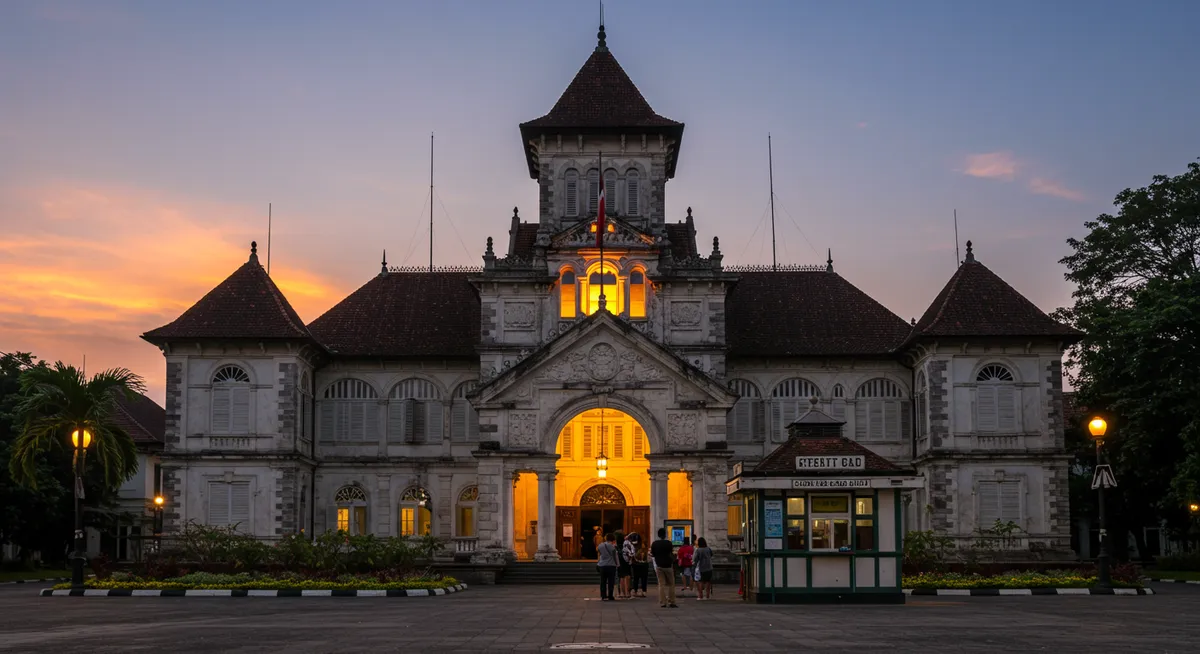
Lawang Sewu History & Tickets: A Semarang Guide
Table of Contents
Want to find the best travel deals for this destination? Chat with our travel hacking specialist!
Get Travel HacksCategory: lawang-sewu-history-and-tickets
Discovering Lawang Sewu: History, Architecture, and Practical Visit Tips
Having explored many historical landmarks across Asia, few compare to the intriguing allure of Lawang Sewu in Semarang. This magnificent structure, known for its distinctive architecture and rich past, offers a captivating journey into Indonesia's colonial era. This guide will delve into the profound Lawang Sewu history and tickets information, ensuring you're fully prepared for an enlightening visit. From its origins as a railway headquarters to its modern-day status as a popular tourist attraction, Lawang Sewu promises a compelling experience. To enhance your journey, consider our comprehensive Semarang Travel Guide, which provides even more insights into this vibrant city.
The Storied Past of Lawang Sewu
Lawang Sewu's compelling journey began in 1904, serving as the headquarters for the Dutch East Indies Railway Company (NIS). This building, often called the 'Thousand Doors' due to its numerous arches and windows, was a symbol of Dutch colonial power and engineering prowess. Its strategic location in Semarang made it a pivotal hub for railway operations across Java. During World War II, the Japanese occupation brought a darker chapter, transforming the building into a prison and torture site, contributing to its eerie reputation. Understanding the profound Lawang Sewu history offers context to its grand, yet somber, presence. From my own visits, witnessing its transformation from a bustling office to a preserved relic of the past is truly remarkable. Consequently, many visitors are drawn to explore its unique heritage.
Architectural Marvels and Haunting Tales
The architecture of Lawang Sewu is a stunning example of Dutch colonial design, blending European elegance with practical tropical adaptations. Its defining feature, the eponymous 'thousand doors' (though not literally a thousand, the sheer number is impressive), creates an intricate play of light and shadow throughout its vast corridors. The building's stained-glass windows, grand staircases, and ventilation system were revolutionary for their time. Beyond its architectural beauty, Lawang Sewu is famously associated with numerous ghost stories, stemming from its history as a prison during the war. These tales of spectral sightings and unexplained phenomena add another layer of mystique to the site. When planning your visit, exploring our Things to Do in Semarang guide can reveal other historical gems, ensuring a well-rounded cultural experience.
Your Guide to Lawang Sewu Tickets & Opening Hours
Visiting this historical landmark requires knowing the practical details, especially concerning Lawang Sewu tickets and operating hours. Currently, the entrance fee for local visitors is typically around IDR 10,000 to IDR 20,000, while foreign tourists might pay slightly more, usually IDR 30,000. Prices are subject to change, so it's always wise to check locally or on official websites. The building is generally open daily from early morning until late afternoon, often between 7:00 AM and 9:00 PM, allowing ample time for exploration. From my experience, arriving early helps avoid crowds and capture better photographs. Furthermore, guided tours are available on-site for a small additional fee, offering deeper insights into the building's complex past. For optimal comfort and less humidity, considering the Best Time to Visit Semarang is highly recommended.
Tips for a Memorable Lawang Sewu Visit
To truly appreciate Lawang Sewu, some practical tips can enhance your experience. Firstly, wear comfortable shoes, as you’ll be doing a fair amount of walking through its extensive grounds. Secondly, consider hiring a local guide. Their anecdotes about the Lawang Sewu history and tickets process, combined with traditional tales, bring the building to life in a way a self-guided tour cannot. Additionally, photography is permitted, so bring your camera to capture the stunning architecture. I always recommend allocating at least 1.5 to 2 hours for your visit to fully absorb the atmosphere and details. Finally, ensure you stay hydrated, especially during Semarang’s warmer months. Planning a Semarang 3-Day Itinerary can seamlessly integrate Lawang Sewu into a broader exploration of the city.
Frequently Asked Questions
What is the historical significance of Lawang Sewu?
How much are the tickets for Lawang Sewu?
Is Lawang Sewu truly haunted?
Lawang Sewu stands as a compelling testament to Semarang's past, blending architectural grandeur with a haunting history. Understanding the complex Lawang Sewu history and tickets information is key to a rewarding visit. From its colonial origins to its role in wartime, every corner tells a story, making it a must-see landmark in Indonesia. Don't miss the opportunity to explore this iconic site firsthand. For more travel inspiration and planning tools, visit Plan Vacation Asia to unlock unforgettable adventures across the continent.